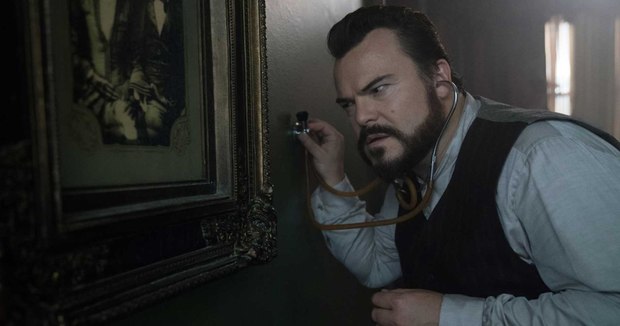VFX supervisor Alexandre Lafortune and his team create griffins, automatons and a mystical time piece at the very heart of Eli Roth’s magical adventure.

‘The House with a Clock in Its Walls.’ All images © Storyteller Distribution Co., LLC. Before and final images courtesy of Rodeo FX.
Director Eli Roth’s magical adventure, The House with a Clock in Its Walls, tells the tale of a young orphaned boy, Lewis, living with his eccentric Uncle in a creaky old house with a mysterious tick-tocking sound – when he accidentally wakes the dead, he unlocks the town’s secret world of warlocks and witches, and ends up on a secret mission to find a doomsday clock that has the power to end the world.
Based on the first volume in John Bellairs’ famous children’s book series and illustrated by legendary author and illustrator Edward Gorey, The House with a Clock in Its Walls stars Jack Black as Uncle Jonathan, Cate Blanchett as his neighbor and best friend, Mrs. Zimmerman, and Owen Vaccaro as our 10-year-old hero.
Led by VFX supervisor Alexandre Lafortune, Rodeo FX’s team of artists was tasked with designing some of the most visually complex creatures and set pieces in the film, including griffins, terrifyingly murderous automatons, and the room of the movie's titular mystical clock. Rodeo, with over 500 artists working across studios in Montreal, Quebec, Los Angeles and Munich, had more than 150 artists working on various aspects of the film.
For Lafortune, who previously handled VFX supervisor duties on films like Sicario: Day of The Soldado, Jumanji: Welcome to the Jungle and Arrival, work on Clock began in late 2017. “We were brought on the project a few weeks before Christmas 2017, when shooting had almost wrapped,” he notes. “My main priorities were to work closely with Louis Morin, the film’s overall VFX supervisor, and to creatively and technically drive our Rodeo FX team of roughly 70 to bring the director’s vision to life.”
The project involved two major areas of work: bringing life to a myriad of inanimate objects and turning practical sets into otherworldly magical realms. According to Lafortune, “We were tagged to create a wide variety of visual effects that would make the magic of the house come to life. Each sequence had its own type of challenge, with a lot of different assets to build. Sometimes we had to create realistic movements for things that don’t exist in the real world, such as flying books, creepy automatons and a living griffin topiary. Other times, we had to take a set that had already been built and add an extra dimension of size or weirdness, such as the Clock Room.”
Working from production supplied concept art, Lafortune’s team expanded and refined the look and final design of a number of key elements and environments they created for the film. “For the Clock Room, the design was established by the production team,” he explains. “We received concept art, which inspired its final look. Our main design work was on the vegetal griffin, a creature that pops up later in the film that is made of shrubbery and farts leaves. They production team had created a giant, stationary version of the griffin that gave the actors something to react to -- we had to take all the dimensions and proportions of this structure and make it come to life. For the automatons, there were a series of stationary automatons, as well as a couple that Steven Spielberg had in his personal collection. We made them come to life with creepy zombie-like movements.”
Creating both the Clock Room and griffin proved particularly challenging. “The biggest challenge our team faced was the griffin,” Lafortune describes. “This creature was made up of different kinds of vegetation - plants, twigs, leaves, etc. - and so it had to move like it really was a mass of all these parts. Creating all the organic parts and animating all the movement really pushed our pipeline. This took numerous simulations and tweaks, which made it harder to work on in our pipeline with all the software it required. Another challenging sequence was the Clock Room, for which we built a multitude of assets -- one of the shots features 450 pieces of gears and pipes. All these gears had to look like they worked and linked together, though this ensemble would be too convoluted, and the room too large, to function in real life.”
Rodeo also provided previs support for some of the film’s automaton sequences. “The Rodeo FX internal previs team worked with the production to create previs for the automatons prior to the shoot, using the Unreal Engine,” Lafortune notes. “We specifically worked on the sequence in which the characters enter a room and encounter the slowly awakening automatons. Previs took three weeks and was later used to guide the lenses and the placement onset. We were tasked with the shot of the automatons’ chamber, and the previs we did was very close to the final result, especially the look and the lighting.”
For Lafortune, however challenging, the project was equally rewarding. “On this film, every sequence was different from one another, each one was challenging and unique in its own way,” he concludes. “Personally, I loved working on the automatons; we did a lot of research into how these weird creations would move and act when functioning, ultimately settling on a movement style that was halfway between a robot and a zombie. I’m really proud of all the work that our team did on their creepy appearance, and on their interactions with the characters. And, between us, since we’re all film buffs, the flying books sequence was actually heavily inspired by Alfred Hitchcock’s The Birds!”
Dan Sarto is Publisher and Editor-in-Chief of Animation World Network.

















